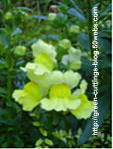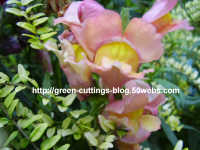Plant of the week. The Snapdragon (Antirrhinum majus)
Snapdragon ![]()
(Antirrhinum majus)
 The name snapdragon refers to the formation of the flowers. If the flowers are squeezed together then it looks like the mouth of a dragon opening and closeing. The Snapdragon or (Antirrhinum majus) is closely related to the Toadflax. The Antirrhinum can be seen growing naturaly is the side of building walls and on chalk cliffs in Britain. The Antirrhinum is not a native plant to Britain but it originates from the mediterranean islands. It has escaped from well maintained gardens by seed carried on the wind and by birds to establish itself in our native wildflower collection. There are a few herbal uses for the Antirrhinum, in the older days they used to use the plant as a preservative to ward off the evil withcraft, they also used to use its close relative the toadflax to do the same job.
The name snapdragon refers to the formation of the flowers. If the flowers are squeezed together then it looks like the mouth of a dragon opening and closeing. The Snapdragon or (Antirrhinum majus) is closely related to the Toadflax. The Antirrhinum can be seen growing naturaly is the side of building walls and on chalk cliffs in Britain. The Antirrhinum is not a native plant to Britain but it originates from the mediterranean islands. It has escaped from well maintained gardens by seed carried on the wind and by birds to establish itself in our native wildflower collection. There are a few herbal uses for the Antirrhinum, in the older days they used to use the plant as a preservative to ward off the evil withcraft, they also used to use its close relative the toadflax to do the same job.  The Antirrhinum is now widley grown in cottage style gardens and in many town and city gardens. It is grown as a half hardy annual but by my experience if planted in a sheltered place and the winter is not to severe then the plant may survive and flower again the folowing year.
The Antirrhinum is now widley grown in cottage style gardens and in many town and city gardens. It is grown as a half hardy annual but by my experience if planted in a sheltered place and the winter is not to severe then the plant may survive and flower again the folowing year.
If you intend to grow the Antirrhinum yourself then it is grown from seed sown in Febuary and March in a warm place like a heated greenhouse or a warm window sill if a greenhouse is not available. If you are starting the plants off on a window sill then fill a 3 and a half inch plant pot with a multi purpose compost. You can use a mixture of 50% compost and 50% horticultural sand. This helps with drainage and stops the water from sitting on top of the compost and allowing molds and algea to form. My personal mixture is roughly 75% multi purpose compost and 25% horticultural sand. Ratio of 3 to 1. (3 compost to 1 horticultural sand.) This mixture I use for all indoor grown seeds and I find it works rather well. Fill the pot with the mixture and and level off the compost. Press down very lightly with a round flat object like for example the base of another 3 and a half inch plant pot so the surface of the compost is nice and level.
 Open the seed packet at the top. Make sure you flick the top of the seed packet so any seeds trapped inside at the top of the packet are allowed to fall to the bottom so you do not waste any and they all have a chance to germanate and grow. Once the packet is open then you will see that the seed is very fine. A good tip for sowing fine seed is to use very fine and very dry horticultural sand. It is like a dry fine salt in consistance. Put a pinch or two of the dry fine horticultural sand into the seed packet and folding over the top of the packet closing it so no seed escapes gently shake the seed packet so the seed is mixed up with the silver sand. Once that has been done sprinkle the seed and sand evenly over the surface of the compost in your pot and then place the pot in a tray of water so that the compost can absorbe the water from the bottom up so not desturbing the seed. The seed does not need covering with compost because it needs light to germanate. I personally do not do that I like to use a very fine rose head on my watering can then gentle pass the water over the pot from side to side so it gently beds the seed into the compost enough so it has a chance to allow the light through and germinate.
Open the seed packet at the top. Make sure you flick the top of the seed packet so any seeds trapped inside at the top of the packet are allowed to fall to the bottom so you do not waste any and they all have a chance to germanate and grow. Once the packet is open then you will see that the seed is very fine. A good tip for sowing fine seed is to use very fine and very dry horticultural sand. It is like a dry fine salt in consistance. Put a pinch or two of the dry fine horticultural sand into the seed packet and folding over the top of the packet closing it so no seed escapes gently shake the seed packet so the seed is mixed up with the silver sand. Once that has been done sprinkle the seed and sand evenly over the surface of the compost in your pot and then place the pot in a tray of water so that the compost can absorbe the water from the bottom up so not desturbing the seed. The seed does not need covering with compost because it needs light to germanate. I personally do not do that I like to use a very fine rose head on my watering can then gentle pass the water over the pot from side to side so it gently beds the seed into the compost enough so it has a chance to allow the light through and germinate.
Once you have done all of this the only thing to do is to lable the pot with a plant label with the name of the plant and the date that you had sown the seed. Cover with a clear plastic bag and secure with a rubber band. A good tip is to use a bendy straw and inflate the bag once secured. This will add carbon dioxide to the atmosphere inside the bag and give the seedlings a little boost once germinated. The germination should take between 2-3 weeks, depending on the area the seeds are being grown. Once germanated grow on until the seedlings are large enough to handle. Seperate the seedlings and put them in fresh compost in pots or trays and place in a greenhouse or coldframe. Grow on until you have strong plants. I like to plant them out after all frosts have passed in the end of May if you live in the United Kingdom.

<< Home